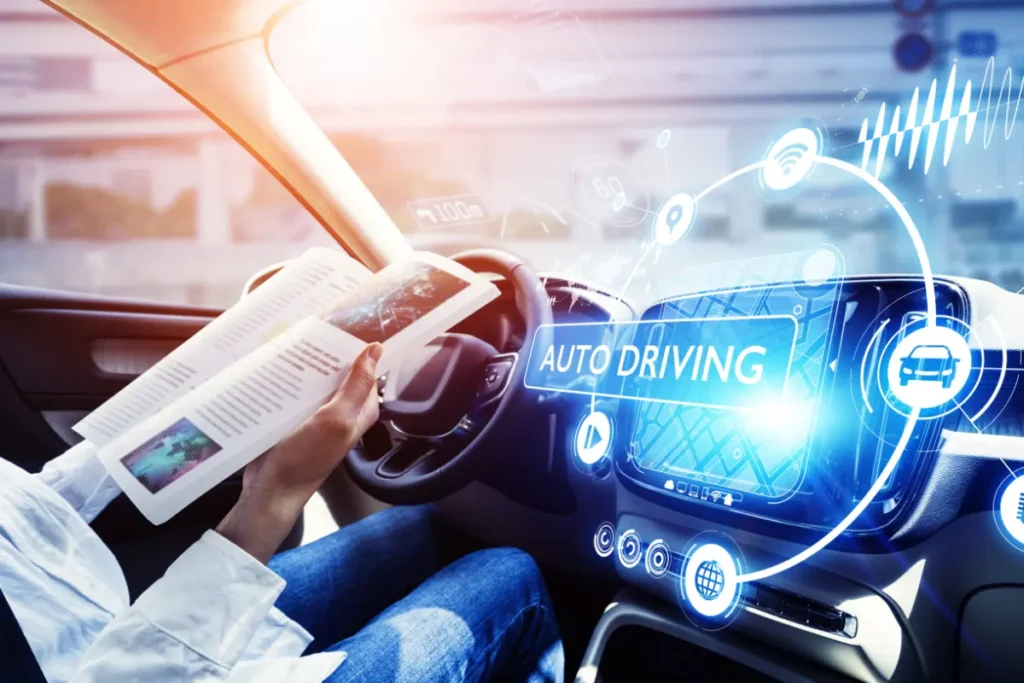
Self-driving vehicles, generally called free vehicles (AVs), are prepared to present one more time of transportation. For independently exploring parkways and streets, these vehicles utilize state-of-the-art advances like sensors, cameras, radar, and man-made consciousness (simulated intelligence) calculations.
Features of Self-Driving Vehicles
1. Security: One of the principal components of self-driving vehicles is their ability to overhaul road prosperity. While human error is the primary cause of car accidents, autonomous vehicles can respond to potential dangers more quickly and precisely.
With their general sensors and consistent data taking care of capacities, self-driving vehicles can free the bet from accidents achieved by human variables like redirected driving, weariness, or weakness.
2. Capability: Self-driving vehicles might conceivably change transportation adequacy. By propelling courses, lessening obstacles, and restricting traffic delays, free vehicles can make travel more reliable and time-useful. Residents can save significant ventures by assigning the endeavor of going to their vehicles, allowing them to focus on various tasks or simply loosen up during their trip.
3. Openness: The availability of independent vehicles may increase further for those who are unable to drive due to age, incapacity, or other restrictions. By giving a strong and open strategy for transportation.
Self-driving vehicles can further develop flexibility and opportunity for a large number of people all around the planet. More seasoned individuals, individuals with impediments, and those living in underserved locales stand to benefit basically from the accessibility features introduced through autonomous vehicles.

Difficulties and Concerns
While the potential of self-driving vehicles is compelling, there are a few issues that need to be addressed before they spread widely.
1. Specialized Challenges: Despite rapid advancements in technology, self-driving cars face unique challenges that must be overcome. These troubles consolidate investigating complex metropolitan circumstances, unraveling eccentric human approaches to acting, and safely working in adversarial atmospheric conditions like significant storms or snow. Subject matter experts and designers are constantly refining free structures to chip away at their display and steadfastness in genuine circumstances.
2. Authoritative Construction: The managerial scene including self-driving vehicles is amazing and creative. Assemblies and managerial bodies are grappling with issues like liability, insurance, prosperity standards, and certification necessities for autonomous vehicles. Spreading out a sensible and complete regulatory construction is key to ensuring the safeguarded sending and action of self-driving vehicles on open roads.
3. Public Insight:
Public affirmation and trust are critical factors influencing the gathering of self-driving vehicles. Worries about possible mishaps, protection, network protection, work uprooting, and the security and constancy of independent vehicles keep on amazing or misgiving many individuals. Keeping an eye on these concerns through tutoring, straightforwardness, and the appearance of safety will be crucial for gaining public trust and affirmation.

Current Situation of Self-Driving Vehicles
Despite the challenges, self-driving vehicle development and testing have made significant progress. Driving associations like Waymo, Tesla, Uber, and traditional automakers are putting enthusiastically into autonomous vehicle development and coordinating expansive testing on open roads.
Tesla’s Autopilot feature, for example, offers advanced driver help capacities, while Waymo’s self-driving taxis are working in select metropolitan networks across the US. Regardless, all gathering of self-driving vehicles is at this point a surprisingly long time away, as associations continue to refine their headways, address regulatory snags, and gain public affirmation.
To determine the maximum capacity of independent vehicles, difficulties such as adaptability, cost, framework, and interoperability must also be addressed. The Inevitable Destiny of Transportation Looking forward, self-driving vehicles might perhaps change transportation and reshape metropolitan conveyability.
Businesses like ride-hailing, transportation services, public transportation, and coordinated operations could be altered by autonomous vehicles. They might make transportation more cost-effective and efficient by reducing congestion, improving air quality, and improving street health.
More Reads: Edge Computing vs. Cloud Computing:7 Key Differences
Conclusion:
self-driving automobiles hold significant promise for the transportation sector in the future. While there are challenges and stresses to address, the reasonable benefits of prosperity, capability, transparency, and practicality are excessively persuasive for even contemplating ignoring. If continued innovation, collaboration, and investment are made, self-driving cars have the potential to change the way we move and usher in a new era of mobility for future generations.
FAQs
- Are self-driving automobiles safe?
While self-driving vehicles might potentially update road security, further testing and refinement are supposed to ensure their reliability and prosperity in obvious conditions.
- When will self-driving automobiles be allowed into general society?
The course of occasions for the unfathomable availability of self-driving vehicles is questionable and depends upon factors like creative movements, regulatory underwriting, and public affirmation.
- How might self-driving vehicles affect occupations?
The far and wide utilization of self-driving vehicles might bring about a deficiency of work in coordinated operations and transportation areas. Regardless, it could moreover set out new positions and open entryways in districts like development improvement, upkeep, and errands.
- What are the essential benefits of self-driving vehicles?
The chief benefits of self-driving vehicles include redesigned road prosperity, further created efficiency, extended accessibility, and diminished normal impact.
- Which occupation will informal regulation play in the sending of self-driving vehicles?
Security norms, risk structures, and functional rules for self-driving vehicles will be set by unofficial law to guarantee their protection and capable joining into society.




